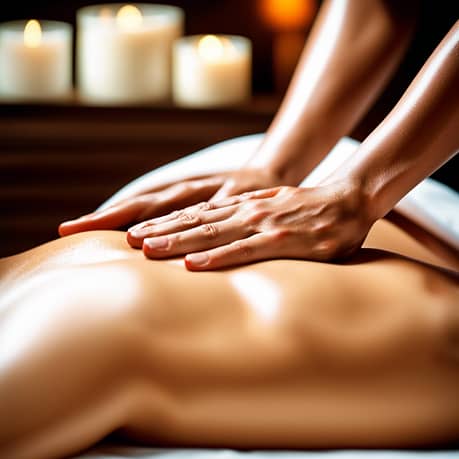Massage for lower back pain offers a gentle, therapeutic approach to alleviate tension and stress in the muscles of the lower back. By targeting specific areas of discomfort, massages can promote relaxation, improve circulation, and reduce inflammation.
In this article, I will discuss how massages can be a beneficial and natural way to find relief from lower back pain. I will also discuss different types of massages, safety considerations, and precautions about massages.
Understanding Lower Back Pain
Lower back pain can be a real difficulty, affecting individuals of all ages.
1. Causes of Lower Back Pain:
- Muscle Strain: It occurs when the muscles supporting your lower back experience excessive or repetitive stress.
- Herniated Discs: Spinal discs that protrude from their normal position, putting pressure on nearby nerves.
- Poor Posture: It happens when you slouch or sit for extended periods and can contribute to lower back pain.
2. Impact on Daily Activities and Quality of Life:
Lower back pain can significantly impact daily activities, making even simple tasks more challenging. Activities like bending, lifting, or even sitting for long periods can cause discomfort and limit mobility. It can also affect your quality of life, leading to decreased productivity and reduced participation in physical and social activities.
Benefits of Massages for Lower Back Pain
1. Relieving Muscle Tension and Reducing Pain:
Massage therapies help you by addressing muscle tension in the lower back. With targeted manipulation and pressure techniques, massages can loosen tight muscles, release knots, and improve your flexibility, resulting in reduced pain and discomfort.
2. Improving Blood Circulation:
Massages also enhance your blood circulation in the lower back area. The gentle pressure applied during a massage promotes increased blood flow, which helps you deliver oxygen and nutrients to the muscles, helping in your healing and reducing inflammation.
Massage therapy for lower back pain helps in delivering oxygen and nutrients to the muscles. Monitoring your cardiovascular fitness, how well muscles use oxygen for energy during exercise through a VO2 Max Calculator helps assess overall fitness.
3. Promoting Relaxation and Releasing Endorphins:
One of the significant benefits of massages is their ability to induce relaxation. Through soothing strokes and techniques, massages stimulate the release of endorphins, which are natural pain-relieving chemicals in your body. This not only reduces pain but also promotes your sense of overall well-being and relaxation.
4. Addressing Specific Issues:
Massages can effectively target specific issues contributing to your lower back pain. Skilled massage therapists can identify and address tight muscles, trigger points, and joints that may be causing discomfort. By releasing tension and resolving these issues, massages help you to reduce lower back pain and restore proper muscle function.
Thai Massage combines assisted stretching, acupressure, and rhythmic compressions to reduce lower back pain and promote overall relaxation and well-being.
Different Types of Massages for Lower Back Pain
Among the various approaches to managing lower back pain, popular holistic therapies like massage offer a natural and effective solution by targeting muscle tension and promoting relaxation.

Source: TheTechBrain Ai
1. Swedish Massage:
Swedish massage is a gentle and relaxing technique that involves long, flowing strokes, kneading, and circular movements. It aims to improve blood circulation, reduce muscle tension, and promote your overall relaxation. It can provide relief from lower back pain by loosening tight muscles and enhancing relaxation in your targeted area.
2. Deep Tissue Massage:
Deep tissue massage focuses on reaching deeper layers of your muscles and connective tissues. It involves applying more pressure and utilizing slower strokes to target your chronic muscle tension and joints. This technique aims to break down adhesions, improve flexibility, and reduce lower back pain by releasing tension in the muscles and promoting better blood flow.
3. Myofascial Release:
Myofascial release is a technique that loosens the fascia, a connective tissue covering the muscles. It involves gentle stretching and sustained pressure to release your restrictions and improve mobility. Myofascial release can benefit lower back pain by addressing specific trigger points and reducing tightness.
Consulting with a Professional Massage Therapist:
It is crucial to consult with a professional massage therapist to determine the most appropriate technique for your needs. They can assess the specific causes and severity of lower back pain and recommend the most suitable massage technique.
Safety Considerations and Precautions When Massaging Lower Back
Certain medical conditions or injuries may require precautions or contraindicated massages for lower back pain. These may include:
- Acute Injuries: It is crucial to avoid massage therapy immediately after an acute back injury, such as a fracture or severe sprain. Rest and medical attention should be sought first.
- Inflammatory Conditions: If you have inflammatory conditions affecting your lower back, such as disc inflammation, massages may not be suitable. These conditions may require alternative treatments.
- Recent Surgeries: Massages should be avoided in the immediate postoperative period, especially if you have undergone back surgery. Allow your body enough time to heal before considering massage therapy.
- Certain Medical Conditions: People with certain medical conditions, such as blood clotting disorders, cancer, or chronic pain conditions, should consult with their healthcare provider before receiving massages. Special precautions or modifications may be necessary.
Incorporating Massages into Lower Back Pain Management
1. Regular Massage Sessions:
Regular massage sessions can play a key role in managing your lower back pain. The benefits of massages, such as relieving muscle tension and promoting relaxation, can help you to reduce pain and improve your overall well-being.
2. Complementary Self-Care Practices:
Alongside massages, incorporating additional self-care practices can increase their effects on managing your lower back pain. These practices may include:
- Stretching: Engaging in gentle stretching exercises specifically targeting the lower back can help improve flexibility, alleviate muscle tension, and enhance the benefits of massages.
- Strengthening Exercises: Performing exercises that strengthen the core muscles and provide support to the lower back can help improve stability and reduce the risk of future pain episodes.
- Maintaining Proper Posture: Paying attention to posture while sitting, standing, and engaging in daily activities can alleviate stress on the lower back, promoting better alignment and reducing pain.
Taking care of yourself in different ways can help with lower back pain. One way is to keep an eye on your BMI using a BMI Calculator. This will give you an idea if your weight is contributing to the pain.
Frequently Asked Questions (FAQ)
Q: Can massages completely eliminate lower back pain?
Massages can help relieve lower back pain by reducing muscle tension and promoting relaxation, but they may not completely eliminate the pain..
Q: How often should I get a massage for lower back pain?
Typically, regular sessions, initially once or twice a week, followed by maintenance sessions, can help you to achieve desired results. You should consult with a professional therapist to determine the best schedule.
Q: Are there any side effects of massage therapy for lower back pain?
Generally, massage therapy is considered safe when performed by a qualified professional. If you have specific health conditions or recent injuries, it is advisable to consult with your healthcare provider before receiving massages.
Q: Can I receive a massage if I have a pre-existing medical condition related to my lower back pain?
It is crucial to inform your massage therapist about any pre-existing conditions, such as herniated discs or inflammatory disorders. This allows them to modify the techniques and ensure your safety and comfort during the session.
Conclusion
Massages can offer a gentle and therapeutic approach to reduce tension and stress in the muscles of the lower back. By targeting specific areas of your discomfort, massages promote relaxation, improve circulation, and reduce inflammation.
While massages may not completely reduce lower back pain for everyone, so, seeking a professional massage therapist is crucial for personalizing your approach and maximizing the benefits of massages for lower back pain relief.






